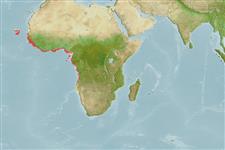Classificação / Names
Common names from other countries
Referência principal
Tamanho / Peso / Idade
Max length : 60.0 cm TL macho/indeterminado; (Ref. 57395); common length : 45.0 cm TL macho/indeterminado; (Ref. 3660)
Length at first maturity
Lm 13.1 range ? - ? cm
Ambiente
; marinhas; Água doce; estuarina demersal; intervalo de profundidade ? - 100 m (Ref. 57395), usually 20 - 50 m (Ref. 2683)
Clima / Intervalo
Tropical; 20°C - ? (Ref. 2799), preferred 25°C (Ref. 107945); 20°N - 23°S, 26°W - 16°E
Distribuição
Descrição breve
Espinhos dorsais (total): 11 - 12; Raios dorsais moles (total): 15-17; Espinhos anais 3; Raios anais moles: 8 - 9; Vértebras: 27. Diagnosis: body oblong and compressed, not very deep; snout short and pointed, distinctly longer than eye diameter; 2 anterior pores on chin, followed by a median pit bearing openings of another pair of pores; a deep groove and a pore above maxilla, below the preorbital bone; second anal fin spine longer and stouter than third; caudal fin slightly forked; scales slightly ctenoid; 4-5 scale rows between lateral line and middle of spinous dorsal-fin base; swim bladder simple, without anterior horns (Ref. 57395).
Coloration: silvery, with round, dark brown and irregularly scattered spots following scale rows on back and sides; dorsal and caudal fins grey; a dark spot at angle of opercle (Ref. 57395).
Categoria na Lista Vermelha da IUCN (Ref. 115185)
Ameaça para o homem
Harmless
Utilização humana
Pescarias: pouco comercial
Mais informação
ReferênciasAquaculturaPerfil para aquaculturaEstirpesGenéticaFrequência dos alelosHereditariedadeDoençasProcessamentoMass conversion
ColaboradoresFotografiasStamps, CoinsSonsCiguateraVelocidadeTipo de nataçãoÁrea branquialOutras referênciasCérebrosVisão
Ferramentas
Relatórios especiais
Descarregue XML
Fontes da internet
Estimates of some properties based on models
Phylogenetic diversity index
PD50 = 0.5000 many relatives (e.g. carps) 0.5 - 2.0 few relatives (e.g. lungfishes)
Nível Trófico
3.3 ±0.50 se; Based on food items.
Resiliência
Médio, tempo mínimo de duplicação da população 1,4 - 4,4 anos (K=0.3)
Vulnerabilidade
Moderate vulnerability (36 of 100)
Categoria de preço
